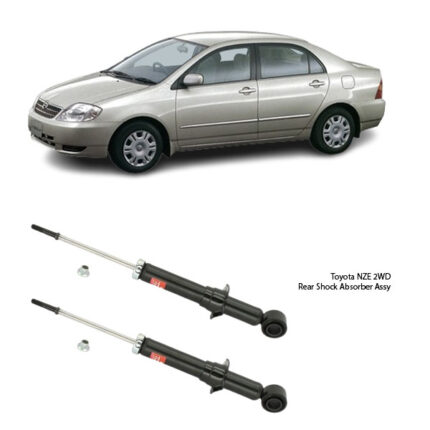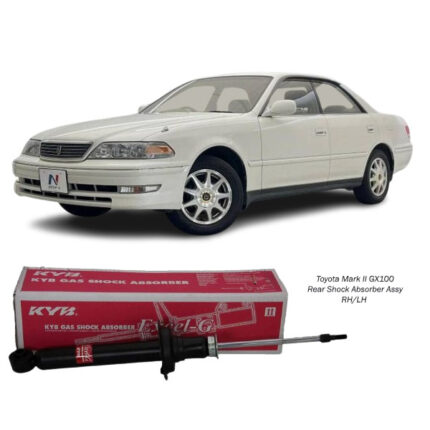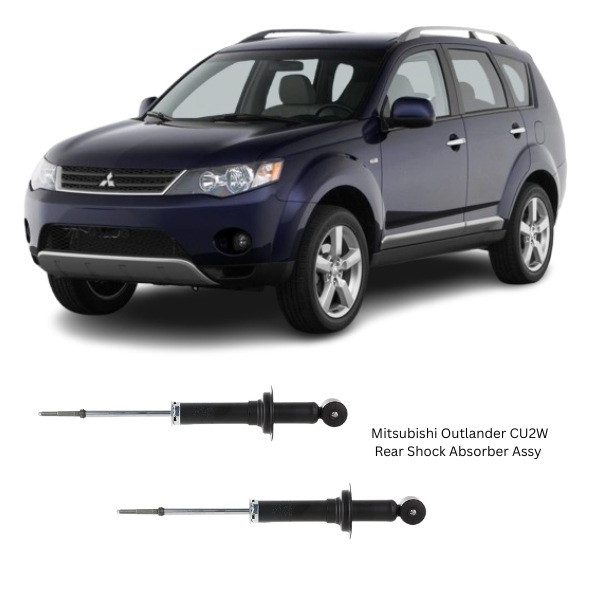Get Mitsubishi Outlander CU2W Rear Shock Absorber Assy 341318 in Kenya
The Rear Shock Absorber Assembly is an essential component of a vehicle’s suspension system, precisely engineered to control rear wheel movement, absorb vibrations and impacts from the road, and ensure driving stability and comfort. Serving as a dynamic link between the vehicle chassis and its rear wheels, it plays a pivotal role in smoothing the ride, enhancing traction, and preserving tire integrity under varying load and terrain conditions.
Primary Role and Functionality
While the rear suspension bears less of the vehicle’s braking load compared to the front, it plays an equally crucial role in maintaining overall balance, especially when the vehicle is loaded or traveling over uneven surfaces. The shock absorber’s primary function is to dampen oscillations—in other words, to absorb the energy generated by the springs as they compress and release. This damping action prevents uncontrolled bouncing, swaying, and tire instability, ensuring that the rear wheels stay firmly planted on the road.
In real-world driving conditions, the rear shock absorber assembly enhances:
-
Ride smoothness over potholes, gravel roads, or speed bumps
-
Rear-end stability during acceleration and cornering
-
Load management when carrying passengers or cargo
-
Braking performance by maintaining road contact
Design and Construction
A typical Rear Shock Absorber Assembly comprises a strong cylindrical housing, a piston rod, internal valving, and hydraulic or gas-filled chambers. It can follow either a twin-tube or mono-tube design depending on the application, with mono-tube shocks offering higher performance characteristics and better heat dissipation.
Key components include:
-
Piston and piston rod: This moves through hydraulic fluid or gas, generating resistance (damping) to motion.
-
Compression and rebound valves: These control how quickly or slowly the fluid moves between chambers, tuning the damping characteristics.
-
Gas chamber (nitrogen): In gas-charged shocks, a pressurized nitrogen chamber prevents the formation of bubbles in the fluid, which can compromise damping performance.
-
Dust boots or bellows: These protect the shaft from dust, moisture, and debris.
-
Bushings and mounting brackets: These interface with the chassis and axle to secure the shock absorber in place and reduce metal-to-metal contact.
Some rear shock absorber assemblies may also incorporate features like self-leveling systems, external reservoirs, or variable damping, especially in vehicles designed for off-road or heavy-duty use.
Materials and Durability
To withstand years of demanding use, rear shock absorbers are manufactured using robust, corrosion-resistant materials:
-
The outer housing is often made from steel or aluminum, treated with anti-corrosion coatings or powder finishes to prevent rust.
-
The piston rod is typically chrome-plated for low friction and superior resistance to wear.
-
High-quality seals are used to prevent oil or gas leaks under pressure and heat.
Internal components are carefully engineered to perform under repeated stress, pressure fluctuations, and temperature extremes without degradation. This ensures long service life and consistent performance.
Performance Features
A well-performing rear shock absorber assembly offers the following:
-
Controlled Damping Force: Absorbs energy during both compression (downward motion) and rebound (upward motion), keeping the rear axle stable.
-
Ride Comfort: Mitigates the effects of road imperfections, reducing jolts and vibrations transferred to the vehicle body.
-
Handling and Load Stability: Maintains rear wheel contact and limits excessive suspension travel when accelerating, braking, or cornering.
-
Noise and Vibration Reduction: Bushings and mountings help absorb shocks and isolate road noise.
Installation and Alignment
Installation of the rear shock absorber assembly is a relatively straightforward process, typically bolted to the frame or unibody at one end and to the axle or suspension arm at the other. However, proper torqueing of bolts, alignment of bushings, and inspection of adjacent components (like springs or control arms) are vital for optimal performance.
It is advisable to:
-
Replace both left and right rear shocks simultaneously to maintain balance.
-
Inspect shock mounts and rubber bushings for cracks, deformation, or fatigue.
-
Check wheel alignment and suspension geometry after installation for smooth handling.
Signs of a Worn Rear Shock Absorber
Over time, rear shocks can lose effectiveness due to internal wear, fluid leakage, or damage. Symptoms indicating replacement is necessary include:
-
Unstable rear-end during acceleration
-
Rear squat or dipping under load
-
Persistent bouncing after hitting a bump
-
Clunking noises from the rear suspension
-
Oil residue on the shock body
-
Tire scalloping or uneven wear
-
Poor ride quality or excessive vibration
Driving with worn rear shock absorbers not only compromises comfort but also endangers safety, especially when carrying heavy loads or navigating sharp turns.
Maintenance and Inspection Tips
While shock absorbers are considered maintenance-free, routine checks during servicing can extend their lifespan:
-
Inspect visually for leaks, rust, or deformation
-
Check for bent or cracked brackets
-
Ensure dust boots are intact and not split
-
Monitor ride quality changes over time
Avoiding overloading the rear axle and driving cautiously over rough surfaces helps reduce stress on the rear shocks.
Advantages of a Quality Rear Shock Absorber Assembly
-
Enhanced Ride Comfort – Smooths road vibrations and reduces cabin movement.
-
Stable Load Handling – Provides confidence when transporting cargo or passengers.
-
Improved Safety – Keeps rear wheels grounded during rapid maneuvers or emergency braking.
-
Extended Tire Life – Prevents excessive tire bounce that causes irregular wear patterns.
-
Balanced Handling – Works in harmony with the front suspension for coordinated vehicle dynamics.
-
Quiet Operation – Isolates road noise and minimizes harsh impacts.
Applications and Use Cases
The rear shock absorber assembly is suitable for a wide range of driving conditions, including:
-
Urban commuting, where potholes and road imperfections are common.
-
Highway cruising, where stability at speed is crucial.
-
Off-road travel, where rugged damping is needed.
-
Heavy-duty use, especially in vehicles carrying cargo or towing.
Follow us on Facebook for more parts.




